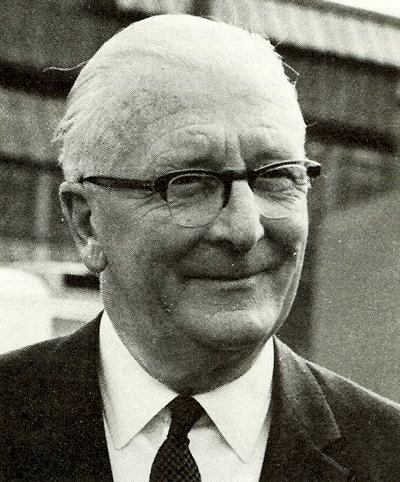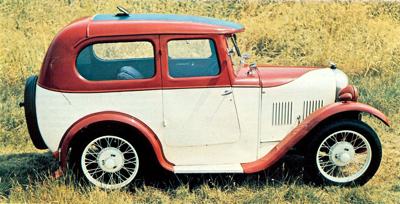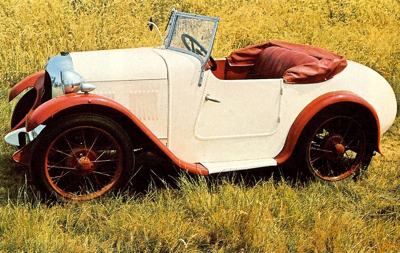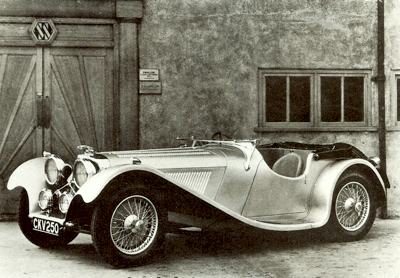William Walmsley
The Swallow story began in a Blackpool garage, where a young man named William Walmsley was engaged in the profitable hobby of refurbishing ex-War Department Triumph motor-cycles to meet the post-World War 1 demand for wheeled transport. In a desire to grow the company, he began to build sporting sidecars, helped by his sister and his wife.
William Lyons
Among his customers was the son of the local piano manufacturer, twenty-year-old William Lyons, who suggested that the two should go into partnership to manufacture sidecars in quantity-perhaps ten or more weekly. As soon as Lyons was 21, the Swallow Sidecar company was formed - on 4 September 1922, with a capital of UK�1000 raised on the credit of the partners' fathers.
They moved into a larger factory, in two of the three storeys of an old building at 7-9 Bloomfield Road, Blackpool, with a total manpower of eight. The Swallow Sidecars, octagonal in cross section and panelled in polished aluminum, looked like little Art Deco airships, their sporting lines contrasting strongly with the average contemporary sidecar, whose 'sit-up-and-beg' styling appeared to be based on the household bath.
Hardly surprisingly the Swallow sidecars attracted both attention and customers and, before long, sales were going through the roof, and the fledgling company was compelled to look for a larger factory; this was in the summer of 1926. They found what they were seeking at Cocker Street, Blackpool, and, within two days, the company and its thirty employees had moved into the new works, aided only by a hired pantechnicon (horse drawn removalist van) and driver.
Herbert Austin's Seven
They were now able to fulfil an ambition of branching out into car bodywork, and the car they chose to endow with specialist coachwork was, interestingly enough, the car which most threatened their livelihood as sidecar manufacturers. Sir Herbert Austin's little
Seven had appeared four years before, one of the parameters in its design being that it must occupy the same ground area as a motor-cycle combination. In terms of price, it could undercut the more expensive sidecar outfits. In terms of appearance, the
Austin Seven was unashamedly utilitarian and square rigged, though.
The Austin Swallow
Swallow imparted to their coachwork an exaggerated voluptuousness which made it stand out from other attempts to coachbuild on the Seven. Not that the Austin Swallow was particularly well proportioned, as its bustle-like tail stuck out too far at the back, and its new, rounded radiator cowl was set ahead of the front axle. However, it was just what was required by a generation of motorists who wanted something more individual, but did not have correspondinly deep pockets with which to realise their dream. Announced in May 1927, the Austin Swallow was an immediate success, as its list price of �175 included most of the refinements conspicuously absent from the standard item; for another �10, customers could have a hinged hardtop instead of the folding hood.
The Swallow Side Car and Coachbuilding Company
So, the Swallow Sidecar Company became the Swallow Side Car and Coachbuilding Company, manufacturers of sidecars and light-car bodies, coach painters and trimmers. Three months after the appearance of the Austin Swallow, the company announced the Morris-Cowley Swallow two-seater, but it looked too much like the MG (without that marque's added performance) to prosper, and only a few examples were built. Swallow were also rumoured to have produced the bodies for the ephemeral Sports Clyno while they were still at Bloomfield Road, but none of the employees from that era could remember this when questioned many years later, and we cannot produce any evidence.
 William Lyons, the power behind Swallow and the founder of Jaguar. He was eventually knighted for his services to the motor industry of Great Britain.
William Lyons, the power behind Swallow and the founder of Jaguar. He was eventually knighted for his services to the motor industry of Great Britain.
 1927 Austin Swallow Mark I. It was produced in time for the 1928 London Motor Show.
1927 Austin Swallow Mark I. It was produced in time for the 1928 London Motor Show.
 1929 Austin Swallow Mark II. The Austin Swallow was released in 1927, and was based on the Austin Seven. It cost UK£175 when released.
1929 Austin Swallow Mark II. The Austin Swallow was released in 1927, and was based on the Austin Seven. It cost UK£175 when released.
 1937 SS100, shown here with the Jaguar radiator emblem.
1937 SS100, shown here with the Jaguar radiator emblem.
|
In any case, the Austin Swallow was prospering mightily. In 1928, when a four-seater saloon was added to the range, Austin Seven chassis were arriving in batches of fifty-although there was nowhere to store them at Cocker Street, and the company's 'temporary' storage facilities in the goods yard of Blackpool North station was rapidly exhausting the goodwill of the railway staff. Weekly output had reached a dozen cars and sidecars, and the inadequacies of the Cocker Street factory had become all too apparent. Swallow moved once again and, as the production of sidecars was rapidly taking second place to the building of car bodies, the firm moved nearer the source of their chassis, to Foleshill, Coventry, in November 1928.
The Standard Ensign
It might have seemed an inauspicious time to make a move, with the depression just around the corner, but in fact the financial crisis helped Swallow, as many people who found themselves in 'reduced circumstances' bought Swallow-bodied cars as a cheap form of individual motoring. At the 1929 Olympia Show, it was seen that Swallow had extended their range, too, and were now producing enlarged versions of the Austin coachwork on Swift Ten, Fiat 509A and, most significantly, Standard Big Nine chassis. In 1931 William Lyons, took a step nearer becoming a car manufacturer in his own right when he announced a new conversion, on the six-cylinder Standard Ensign chassis, thus establishing a choice of power unit which was to last into the 1940s.
WAIT! THE SS IS COMING!
Then, as the 1931 Motor Show drew near, tantalising advertisements began to appear: 'SS is the name of a new car that's going to thrill the hearts of the motoring public and the trade alike. It's something utterly new ... different ... better. Long ... low ... very low ... and very FAST! At the Show two SS coupes of surpassing beauty will be presented. WAIT! THE SS IS COMING!' On 9 October the SS duly came. No one was quite sure, not was the company saying, whether the initials stood for 'Standard Swallow' or 'Swallow Special' but, whatever the truth of the matter, the new cars had engines and chassis built by Standard to Lyons' specifications, and were fitted with coachwork of exaggerated, almost meretricious, lowness.
While the standard Standard Sixteen stood 5 ft 8 in high, the SS was only 4 ft 7 in off the ground, thanks to a double-dropped chassis frame and a minimum of headroom. Apart from the SS Sixteen, there was also an SSII, based on the Standard Little Nine; the 16 hp coupe (no other style was available) was UK�298 and the 9 hp coupe was UK�198. The original SSI was a car of such exaggerated lines that the rear passengers sat in a curious little dickey seat in the luggage trunk. Overdone the styling may have been, but it created the desired effect. Frank Hough, of Henlys, their London distributor, offered to buy half of the first year's output, provided that at least 1000 cars were produced.
The Beauty That is Swallow
Even though the actual figure fell over 200 short of this target, public response was sufficient to cement a lasting bond between Henlys and SS. The wilder excesses of the styling were toned down in 1932, in which year a 20 hp six also became available. Showtime advertising extolled 'the beauty that is Swallow', although the specialist bodies on production chassis were being phased out in favour of the SS line. 'Was beauty in car design ever before expressed in such striking fashion as it is in the I933 SS?' queried the company's advertising. 'Olympia will. again emphasise that its individuality and distinction are beyond comparison.
A full four-seater saloon with sliding roof, comprehensive and tasteful equipment, the SSI is a car to be desired by the motorist of discrimination.' Late in I934, the SS Car Company Limited was floated to take over car manufacture, while sidecar production was continued by the Swallow Coach building Company (I935) Limited. The firm had already expanded to fill the thirteen-acre Foleshill site, and had acquired neighbouring land for further development. At the time of the reorganisation, Mills & Fullford (the original inventors of the sidecar) were supplying chassis for sidecar bodies, and from 1935 this side of the activity passed to Grindlay-Peerless, who provided the company's sidecar chassis up to the outbreak of war.
SS Jaguars
The SSI and SSII were continued until 1936, having been augmented by the SSI Airline saloon late in 1934 and the SSI Drophead and the SS90 sports in early 1935; later that year, Walmsley resigned, to build caravans of advanced design. In the autumn of 1935, the first SS Jaguars appeared, followed by the classic SS 100 sports; they were powered by a new overhead-valve version of the Standard-based engine, developing 102 bhp from 2.5 liters. There was a 1.5-liter side-valve Jaguar sedan which also gained overhead valves the following year, while a 3.5-liter overhead-valve engine was added in the autumn of 1937.
Output rose to around 250 cars a week, for the Jaguar was a far more practical mode of transport than its predecessor. The SS Jaguar offered a comfortably compliant ride in a middle-class sort of a way, although not particularly well designed from the driver's point of view. After the war, it did not really matter whether SS stood for 'Swallow Special' or 'Standard Swallow', for the letters had acquired another, more sinister meaning from another source ... and SS Cars Limited became
Jaguar Cars.
Also see: From Swallow Sidecars To The Jaguar XJ - The William Lyons Story 